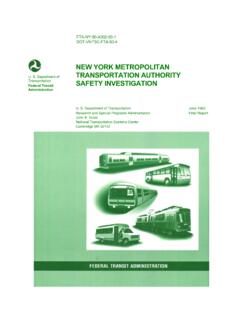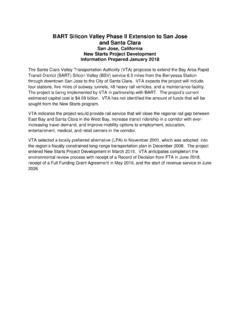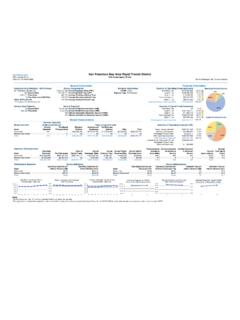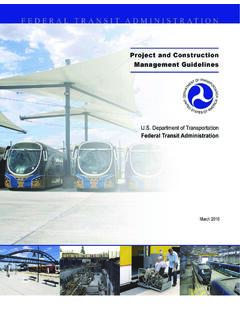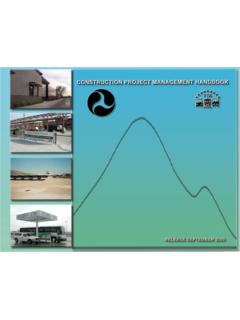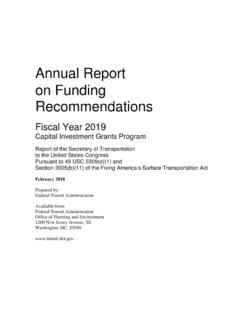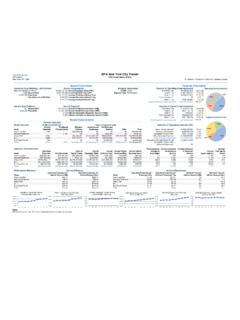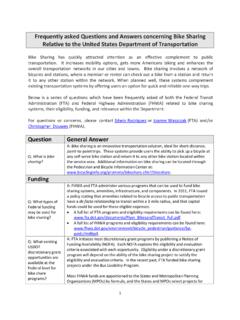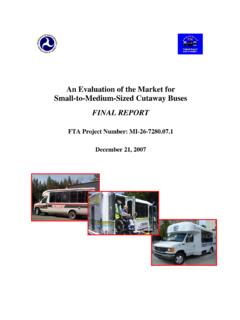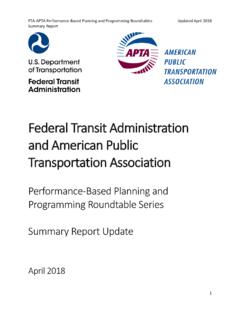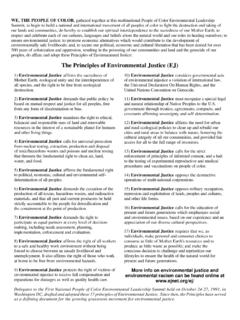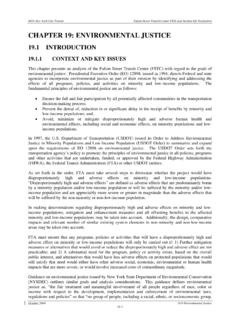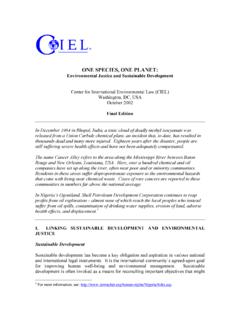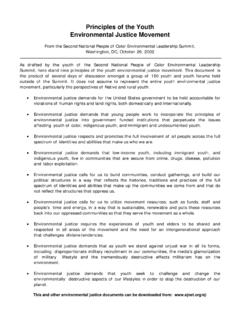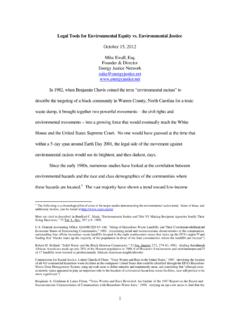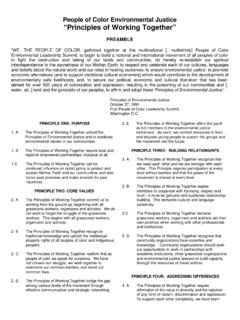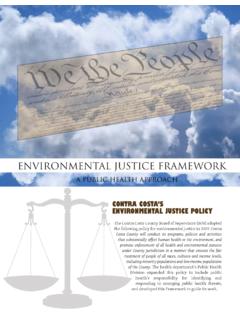Transcription of CIRCULAR - FTA
1 CIRCULAR Department of Transportation Federal Transit Administration FTA C August 15, 2012 Subject: environmental justice POLICY GUIDANCE FOR FEDERAL TRANSIT ADMINISTRATION RECIPIENTS 1. PURPOSE. The purpose of this CIRCULAR is to provide recipients of Federal Transit Administration (FTA) financial assistance with guidance in order to incorporate environmental justice principles into plans, projects, and activities that receive funding from FTA. 2. AUTHORITY. a. Executive Order 12898, Federal Actions to Address environmental justice in Minority Populations and Low-Income Populations, dated February 11, 1994. b. DOT Order (a), Actions to Address environmental justice in Minority Populations and Low-Income Populations, 77 FR 27534, May 10, 2012. c. Federal Transit Laws, Title 49, United States Code, Chapter 53. 3. WAIVER. FTA reserves the right to waive any provisions of this CIRCULAR to the extent permitted by Federal law or regulation.
2 4. FEDERAL REGISTER NOTICE. In conjunction with publication of this CIRCULAR , FTA published a notice in the Federal Register, addressing comments received during development of the CIRCULAR . 5. AMENDMENTS TO THE CIRCULAR . FTA reserves the right to update this CIRCULAR to reflect changes in other revised or new guidance and regulations that undergo notice and comment, without further notice and comment on this CIRCULAR . FTA will post updates on our website at The website allows the public to register for notification when FTA issues Federal Register notices or new guidance. Please visit the website and click on sign up for e-mail updates for more information. Page 2 FTA C 6. ACCESSIBLE FORMATS. This document is available in accessible formats upon request. To obtain paper copies of this CIRCULAR as well as information regarding these accessible formats, call FTA s Administrative Services Help Desk, at: 202-366-4865. Individuals with hearing impairments may contact the Federal Relay Service at 1-800-877-8339 for assistance with the call.
3 _____/s/_____ Peter M. Rogoff Administrator i environmental justice Policy Guidance for Federal Transit Administration Recipients FTA CIRCULAR Table of Contents ACRONYMS .. iii Chapter I environmental justice , Title VI, and Public Transportation .. 1 A. Guiding environmental justice 2 B. Title VI Nondiscrimination Law .. 2 C. How Do Title VI and EJ Work Together? .. 3 D. What Are the Similarities and Differences Between Title VI and environmental justice ? .. 4 E. Conducting an environmental justice 6 F. What Is the Purpose of a Separate CIRCULAR on environmental justice ? .. 8 G. Summary .. 9 Chapter II Conducting an environmental justice Analysis .. 11 A. environmental justice Analysis .. 11 B. Know Your Community .. 12 1. Sources of Demographic Data .. 12 Unit of Geographic 15 2. How Do You Know If An EJ Population Is Present? .. 16 Determining Disproportionately High and Adverse Effects .. 17 Identifying Adverse Effects.
4 17 1. Determining Whether Adverse Effects Are Disproportionately High .. 17 2. Determining Whether Adverse Effect Will Be Borne By EJ 19 III Achieving Meaningful Public Engagement With environmental justice Populations .. 20 A. Public Engagement as Part of Transportation Planning .. 21 B. Getting to Know Your Community .. 22 C. Traditional Public Outreach .. 23 D. Hosting Successful Public Meetings .. 24 ii E. Non-Traditional Outreach .. 27 1. Informal Group Meetings .. 28 2. Digital media .. 28 3. Direct Mail Campaigns .. 29 4. Community Led Events .. 29 5. Partnerships with Community-Based Organizations and Leaders .. 30 F. Summary .. 31 Chapter IV Integrating principles of environmental justice in Transportation Planning and Service Delivery .. 32 A. What Is the Transportation Planning Process? .. 32 B. Planning Tools for Residential Demographic Profiles .. 34 C. Strategies for Public Engagement for Planning Activities .. 35 D.
5 Strategies to Achieve Full Public Participation for Planning Activities .. 36 E. Future Goals and Visions .. 37 F. Transportation Needs and Recommended Projects .. 38 G. Current Operations, Management, and Maintenance .. 39 H. Dynamic Nature of Planning and Public Engagement .. 39 Chapter V Incorporating environmental justice principles into the NEPA Process .. 41 A. Adapting Your EJ Analysis for NEPA.. 42 B. Define the Project Area and Identify EJ Populations.. 43 C. Identify Adverse environmental Effects on EJ Populations .. 45 D. Public Engagement and NEPA .. 48 E. environmental Impact Statements and environmental Assessments .. 49 F. Categorical Exclusions .. 50 APPENDIX .. i A. Definitions .. i B. Authorities .. iv C. References .. viii iii ACRONYMS ACS American Community Survey CAC Community Advisory Council CEQ Council on environmental Quality DOT Department of Transportation EJ environmental justice EO Executive Order EPA environmental Protection Agency FHWA Federal Highway Administration FTA Federal Transit Administration GIS HHS Geographic Information System Department of Health and Human Services LEP Limited English Proficiency MPO Metropolitan Planning Organization NEPA National environmental Policy Act of 1969 OMB Office of Management and Budget STIP Statewide Transportation Improvement Program TIP Transportation Improvement Program This guidance is intended to improve the internal management of FTA with respect to environmental justice .
6 It will not be deemed to create any right, benefit or trust obligation either substantive or procedural, enforceable by any person, or entity in any court against the agency, its officers, or any other person. Compliance with this guidance will not be justiciable in any proceeding for judicial review of agency action. Chapter I Page | 1 Chapter I environmental justice , Title VI, and Public Transportation Executive Order 12898, Federal Actions to Address environmental justice in Minority Populations and Low-Income Populations, requires the Department of Transportation (DOT) and the Federal Transit Administration (FTA), to make environmental justice (EJ) part of our mission by identifying and addressing, as appropriate, disproportionately high and adverse human health or environmental effects of our programs, policies, and activities on minority populations and/or low-income populations (collectively EJ populations ). environmental justice at FTA includes incorporating environmental justice and non-discrimination principles into transportation planning and decision-making processes as well as project-specific environmental reviews.
7 In May 2012, DOT issued an updated internal Order, Actions to Address environmental justice in Minority Populations and Low-Income Populations (DOT Order). The DOT Order updates the Department s original environmental justice Order, which was published April 15, 1997. The DOT Order continues to be a key component of the Department's strategy to promote the principles of environmental justice in all Departmental programs, policies, and activities. DOT Order (a) sets forth the DOT policy to consider environmental justice principles in all DOT programs, policies, and activities. It describes how the objectives of environmental justice will be integrated into planning and programming, rulemaking, and policy formulation. The DOT Order sets forth steps to prevent disproportionately high and adverse effects to minority or low-income populations through Title VI analyses and environmental justice analyses conducted as part of Federal transportation planning and NEPA provisions.
8 It also describes the specific measures to be taken to address instances of disproportionately high and adverse effects and sets forth relevant definitions. The updated DOT Order reaffirms DOT's commitment to environmental justice and clarifies certain aspects of the original order, including the definitions of "minority" populations in compliance with the Office of Management and Budget's (OMB) Revisions to the Standards for the Classification of Federal Data on Race and Ethnicity of October 30, 1997. The revisions clarify the distinction between a Title VI analysis and an environmental justice analysis conducted as part of a NEPA review, and affirm the importance of considering environmental justice principles as part of early planning activities in order to avoid disproportionately high and adverse effects. The updated DOT Order maintains the Chapter I Page | 2 original order s general framework and procedures and DOT's commitment to promoting the principles of environmental justice in all DOT programs, policies, and activities.
9 The Executive Order directs Federal a gencies to identify and address, as appropriate, disproportionately high and adverse human health or environmental effects of agency programs, policies, and activities on EJ populations. A. Guiding environmental justice principles The guiding EJ principles followed by DOT and FTA are briefly summarized as follows: To avoid, minimize, or mitigate disproportionately high and adverse human health and environmental effects, including social and economic effects, on minority populations and low-income populations. To ensure the full and fair participation by all potentially affected communities in the transportation decision-making process. To prevent the denial of, reduction in, or significant delay in the receipt of benefits by minority and low-income populations. You should consider these goals of environmental justice throughout transportation planning and project development, and through all public outreach and participation efforts conducted by FTA, its grantees and subgrantees.
10 In our grant agreements, we require you, as a recipient of FTA funds, to facilitate our compliance with Executive Order 12898 and the DOT Order (a). You facilitate our compliance by incorporating EJ principles into your transportation decision-making process and environmental review documents. B. Title VI Nondiscrimination Law Title VI of the Civil Rights Act of 1964 prohibits discrimination by recipients of Federal financial assistance on the basis of race, color, and national origin, including matters related to language access for limited English proficient (LEP) persons. Under DOT s Title VI regulations, as a recipient of DOT financial assistance, you are prohibited from, among other things, using criteria or methods of administering your program which have the effect of subjecting individuals to discrimination based on their race, color, or national origin. For example, neutral policies or practices that result in discriminatory effects or disparate impacts violate DOT s Title VI regulations, unless you can show the policies or practices are justified and there is no less discriminatory alternative.
